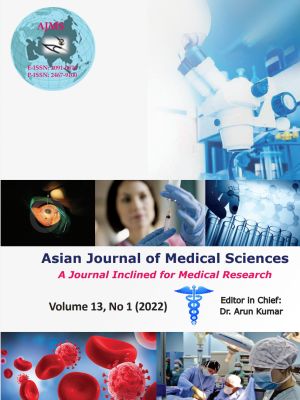Pitfalls in the histological diagnosis of total colonic aganglionosis on appendicectomy specimens
Keywords:
Appendix, Histology, Total Colonic AganglionosisAbstract
Background: Hirschsprung’s disease is the most important cause of functional intestinal obstruction in children. It is characterized by the absence of ganglion cells in the submucosal and myenteric plexuses on histology. In 10% of Hirschsprungs disease patients, involvement of the entire colon is seen in a condition called total colonic aganglionosis (TCA). The absence of ganglion cells in the appendix on histology has been considered diagnostic of TCA. The validity of this histological finding being taken as criteria for diagnosis is not clear.
Aims and Objectives: This study examines the presence and the number of myenteric and submucosal ganglion cells in the appendices of suspected cases of TCA and compares these findings with controls, specimens of acute appendicitis, and histologically normal appendix in pediatric cases.
Materials and Methods: Thirty-six appendix specimens of suspected TCA cases and controls, that is, ten each of acute appendicitis and histologically normal appendix in pediatric age group were included in this study taken up in the pathology department of a tertiary pediatric referral hospital. The presence or absence and the number of ganglion cells in each specimen was semiquantitatively evaluated in a blinded manner. These findings were descriptively compared and analyzed. The difficulties faced by the pathologist in reporting the pediatric appendix specimens were also documented.
Results: The cases and controls showed that aganglionosis and no significant difference were noted in the number of ganglion cells per high power field between the cases and controls. The reporting pathologists enumerated quite a few pitfalls and problems encountered by them in the process of interpreting ganglion cell status of pediatric, particularly neonatal appendicectomy specimens.
Conclusion: Aganglionosis of the appendix on histology may not be an ideal tool for the diagnosis of TCA. Difficulties in histological characterization of ganglion cells, technical errors in tissue embedding and the presence aganglionic skip areas might cause errors in the interpretation of ganglion cell status of appendix specimens, particularly infants, and neonates.
Downloads
Downloads
Published
How to Cite
Issue
Section
License
Copyright (c) 2021 Asian Journal of Medical Sciences

This work is licensed under a Creative Commons Attribution-NonCommercial 4.0 International License.
Authors who publish with this journal agree to the following terms:
- The journal holds copyright and publishes the work under a Creative Commons CC-BY-NC license that permits use, distribution and reprduction in any medium, provided the original work is properly cited and is not used for commercial purposes. The journal should be recognised as the original publisher of this work.
- Authors are able to enter into separate, additional contractual arrangements for the non-exclusive distribution of the journal's published version of the work (e.g., post it to an institutional repository or publish it in a book), with an acknowledgement of its initial publication in this journal.
- Authors are permitted and encouraged to post their work online (e.g., in institutional repositories or on their website) prior to and during the submission process, as it can lead to productive exchanges, as well as earlier and greater citation of published work (See The Effect of Open Access).




